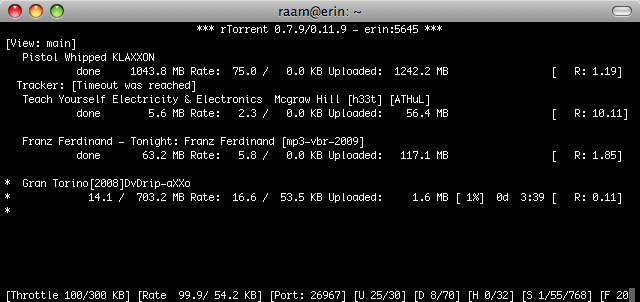I've had plans for a while now to set up a backup system using a Debian Linux server and rsync to back up my MacBook Pro laptop. At first glance, it seemed like it would be pretty straight forward. I've been able to make a bootable copy of my entire MBP using nothing but rsync (thanks to some very helpful directions by Mike Bombich, the creator of the popular, and free, Carbon Copy Cloner software). And by bootable copy I mean I could literally plug in the USB drive and boot my MBP from the drive (hold down the Alt/Option key while booting). Restoring a backup is as simple as running the rsync command again, but in the reverse direction. I know this solution works because I used it when I upgraded to a 320GB hard drive.
To start, I needed to create a big enough partition on the external USB drive using Disk Utility (formatted with Mac OS Extended (Journaled)). I then made a bootable copy of my MBP with one rsync command:
sudo rsync -aNHAXx --protect-args --fileflags --force-change
--rsync-path="/usr/local/bin/rsync" / /Volumes/OSXBackup
But my dream backup system was more unattended. I wanted something that would periodically (a couple times a day) run that rsync command over SSH (in the background) and magically keep an up-to-date bootable copy of my MBP on a remote server.
I love Linux and I jump at any opportunity to use it for something new, especially in a heterogeneous network environment. So when I decided to set up a backup server, I naturally wanted to make use my existing Debian Linux machine (which just so happens to be running on an older G4 Mac Mini).
So, after making a bootable copy of my MBP using the local method mentioned above, I plugged the drive into my Linux machine, created a mount point (/osx-backup), and added an entry to /etc/fstab to make sure it was mounted on boot (note the filesystem type is hfsplus):
/dev/sda /osx-backup hfsplus rw,user,auto 0 0
All that's left to do now is to run the same rsync command as earlier but this time specifying the remote path in the destination ([email protected]:/osx-backup/). This causes rsync to tunnel through SSH and run the sync. Unfortunately, this is where things started to fall apart.
OS X uses certain file metadata which must be copied for the backup to be complete (again, we're talking about a true bootable copy that looks no different than the original). Several of the flags used in the rsync command above are required to maintain this metadata and unfortunately Linux doesn't support all the necessary system calls to set this data. In particular, here are the necessary flags that don't work when rsyncing an OS X partition to Linux:
-X (rsync: rsync_xal_set: lsetxattr() failed: Operation not supported (95))
-A (recv_acl_access: value out of range: 8000)
--fileflags (on remote machine: --fileflags: unknown option)
--force-change (on remote machine: --force-change: unknown option)
-N (on remote machine: -svlHogDtNpXrxe.iL: unknown option)
According to the man page for rsync on my MBP, the -N flag is used to preserve create times (crtimes) and the --fileflags option requires chflags system call. When I compiled the newer rsync 3.0.3 on my MBP, I had to apply two patches to the source that were relevant to preserving Mac OS X metadata:
patch -p1 <patches/fileflags.diff
patch -p1 <patches/crtimes.diff
I thought that maybe if I downloaded the source to my Linux server, applied those same patches, and then recompiled rsync, that it would be able to use those options. Unfortunately, those patches require system-level function calls (such as chflags) that simply don't exist in Linux (the patched source wouldn't even compile).
So I tried removing all unsupported flags even though I knew lots of OS X metadata would be lost. After the sync finished, I tried booting from the backup drive to see if everything worked. It booted into OS X, but when I logged into my account lots of configuration was gone and several things didn't work. My Dock and Desktop were both reset and accessing my Documents directory gave me a "permission denied" error. Obviously that metadata is necessary for a viable bootable backup.
So, where to from here? Well, I obviously cannot use Linux to create a bootable backup of my OS X machine using rsync. I read of other possibilities (like mounting my Linux drive as an NFS share on the Mac and then using rsync on the Mac to sync to the NFS share) but they seemed like a lot more work than I was looking for. I liked the rsync solution because it could easily be tunneled over SSH (secure) and it was simple (one command). I can still use the rsync solution, but the backup server will need to be OS X. I'll be setting that up soon, so look for another post with those details.

